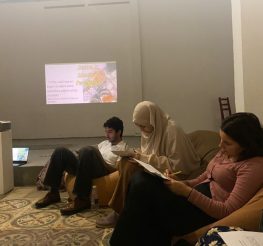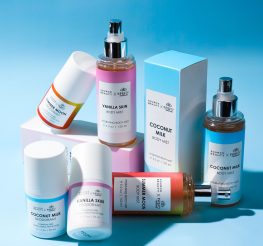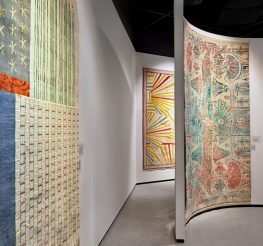‘Passing Faces’ by Kareem Al Qurity at Al Masar Gallery – The Art Lounge
Al Masar Gallery: ‘Passing Faces’ by Kareem Al Qurity
-
157 B 26th Of July St., Floor 0
-
Galleries
-
-
11AM-9PM, Fridays by appointment
Jessica Noble

One piece that particularly caught our attention was titled ‘Polarisation’. The small, rectangular image depicted four groups of people, all facing separate directions and painted in different shades of brown and grey. This particular image was created to highlight the contrasting beliefs, largely politically, in Egyptian society today. Curiously, there is a tiny silhouette of a man praying in the corner; we assumed he might represent religious polarisation or the growing influences of certain political parties, however, the artist himself claimed this detail had little theoretical significance.
Most of the portraits were textured and contrasted against a smooth background to give the impression of sculpting, but on paper.
The largest of Al Qurity’s paintings was a series of three, dramatic, black and white charcoal portraits. Each face displayed a mysterious, stony expression, with the eye sockets left hollow for dramatic effect. The deep, white lines cut across the faces like lashings of rain, whilst water droplets caused a smudging, tear drop effect. We thought this may have been the artists’ way of depicting the depth of the figure’s emotions, imaging their despair. Again, the artist dampened the flames of our imagination by claiming he was simply playing around with the charcoal, experimenting with his technique. Despite resulting in an interesting final piece, the concept behind the masterpieces was a little shallower than our own interpretations.
Also hanging in the exhibition is a series of paintings titled ‘People and the Constitution’; an extension piece from his ‘Safe Haven’ project, which examined the public’s deep feelings about security in the country. The ‘People and the Constitution’ piece is particularly relevant today and highlights the controversial verses from the old constitution. Al Qurity uses the extracts of text to make up the background, on top of which portraits of blank faces sit looking in different directions. Amongst the anonymous faces, there is also a portrait of an Egyptian soldier, possibly implying their involvement in enforcement, despite their personal beliefs.
Undoubtedly, the paintings themselves are both attractive and powerful; however, disappointingly, the theory was a little weak and our imaginations took us further than their intended meanings.
Write your review
recommended
 Restaurants
Restaurants
Where to Eat the Best Egyptian Meals: Top Restaurants for Egyptian Cuisine
Bebo Egyptian food +4 Arts & Culture
Arts & Culture



